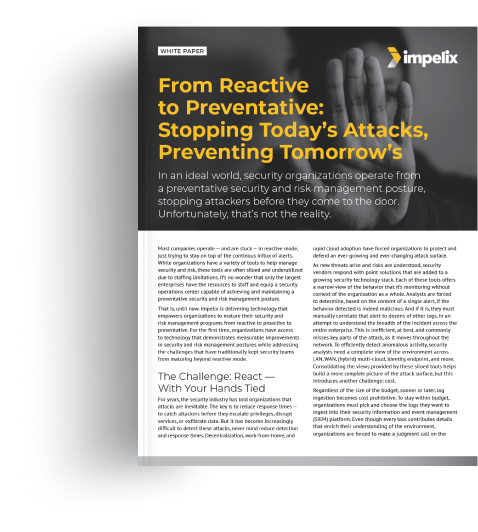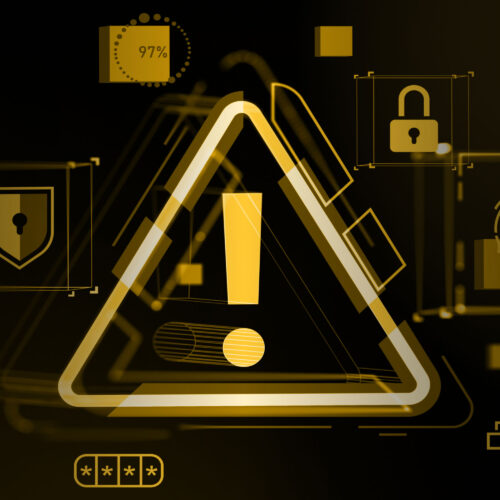Events
Schedule time with us!
contacts@impelix.com
LIVE EVENT
Thursday, March 20, 2025
Los Angeles Cybersecurity Conference
FutureCon Events brings high-level Cyber Security Training discovering cutting-edge security approaches, managing risk in the ever-changing threat of the cybersecurity workforce.
Hilton Los Angeles Airport
Los Angeles, California
Watch
Next Generation Network Security Strategies
For Incident Prevention, Threat Insights, and Network Visibility
Read
WHITE PAPER
In an ideal world, security organizations operate from a preventative security and risk management posture, stopping attackers before they come to the door. Unfortunately, that’s not the reality.
DATASHEET
The ONLY integrated Security, Risk, and Compliance Management Solution. The Impelix IMPACT Platform was built for teams who contend with the burden of ensuring their firms’ cyber and compliance readiness.
BROCHURE
Organizations face considerable obstacles in their efforts to respond to threats in a timely and efficient manner, while ensuring cyber and compliance readiness.
Blog
BLOG
In the ever-evolving landscape of cybersecurity, SecOps teams face a daunting challenge: managing an overwhelming volume of alerts while ensuring critical threats don’t slip through the cracks. Traditional triage methods often leave teams grappling with false positives and operational inefficiencies. Enter the IMPACT Zero Triage Methodology, powered by Narrow AI and Machine Learning, to redefine how security incidents are prioritized and addressed.
BLOG
Today’s security landscape is more complex than ever, with organizations relying on a multitude of tools and technologies. While each tool plays a role in protecting the enterprise, the lack of integration between these systems often leads to fragmented visibility. You shouldn’t rely on endpoint specific POV nor a network-centric view as they do not provide a comprehensive view of the incident across vectors. Vendor-agnostic visibility is the solution, providing a unified view of your entire attack surface.
BLOG
Investing in cutting-edge security tools is essential, but how do you know they’re delivering the value you expect? Validation of security controls ensures that every tool in your tech stack is performing at its best, enabling you to make informed decisions and optimize your defenses.
BLOG
Managing a SecOps budget is a balancing act between ensuring robust security and controlling costs. Impelix IMPACT simplifies this challenge with a flat, predictable pricing model and innovative features that reduce expenses across people, tools, and time.
BLOG
In today’s cybersecurity landscape, organizations face mounting pressure to reduce costs, particularly in their Security Information and Event Management (SIEM) operations. While Forrester is pushing the idea called Data Pipeline Management, I argue that selective data ingestion to manage expenses may create more problems than it solves. In my experience, restricting SIEM data could significantly impair security operations and ultimately prove more costly in the long run.
BLOG
Impelix Spends a Fun Day at the Toledo Tech Loft Doing Purple Team Exercises with Toledo’s Security Community. On Thursday, October 24th, as part of Cybersecurity Awareness Month, members of Toledo’s Cyber community came together to test their skills attacking and defending a simulated three tier network including internal corporate, semi-exposed DMZ, and third-party (supply chain) resources.
BLOG
Eight months ago, UnitedHealth Group, one of the world’s leading healthcare organizations, disclosed a significant data breach that sent shockwaves through the industry. Initially, the incident seemed to be a contained affair, affecting a limited segment of their customer base. Early reports suggested that the personal information of approximately five million individuals had been compromised.
BLOG
By upgrading to the Impelix IMPACT SecOps Platform, MSSPs can unlock numerous business benefits, from operational efficiency and cost savings to enhanced threat detection and proactive defense. The platform’s AI-driven automation, real-time analytics, RBAC, scalability, and advanced reporting capabilities make it an essential tool for MSSPs seeking to stay competitive, improve client satisfaction, and grow their business.
BLOG
Securing your organization isn’t just an important initiative—it’s a race against time and sophistication. With thousands of cyber attacks occurring daily, security operations managers, engineers, analysts, and executives face a constant battle to keep their systems secure. Let’s delve into the key challenges these professionals encounter and explore how the Impelix IMPACT SecOps platform can transform their approach to cybersecurity.
BLOG
The National Institute of Standards and Technology (NIST) recently unveiled the second iteration of its cybersecurity framework, commonly referred to as NIST Framework 2.0. This updated version introduces significant enhancements and changes that reflect the evolving landscape of cybersecurity threats and the need for more adaptive and robust security measures.
BLOG
As a CTO with 25 years of cybersecurity experience, I am never at ease with the state of cybersecurity. It’s not because we’re not doing our jobs, it’s just that our modern-day businesses operate as part of a larger business ecosystem and I am concerned about the additional risks operating like this brings to an organization. Specifically, I am talking about third-party risk.
BLOG
I was thinking recently about the evolution of digital security over the past 25 years. We went from a world of wired connections and office buildings to global networks of cloud resources that are accessed as often from phones and tablets as they are from corporately managed devices. We lived in a world where security consisted of a firewall, antivirus, and a keycard to access the building. And now the average enterprise organization has more than twenty-five security tools in their stack.
BLOG
In the fast-evolving realm of cybersecurity, the role of a Chief Information Security Officer (CISO) is pivotal. Securing an organization goes well beyond the all-too-common approach of “we have a tool for that”. We’re all familiar with the People, Process, Technology (PPT) Framework, but often lose sight of just how directly it applies in the realm of cybersecurity.
BLOG
In today’s digital world, cybersecurity defenses continually lag behind attacks. As technology evolves, so do the threats and vulnerabilities that cybercriminals exploit. In the battle to protect our digital assets and privacy, communal knowledge sharing has become an increasingly important element of a well-rounded cybersecurity plan.
BLOG
In the fast-paced and dynamic world of business that we are in, having a robust enterprise risk management (ERM) framework is crucial for organizations to survive. With the constant evolution of the modern business landscape, it has become increasingly vital for companies to navigate potential risks effectively. By implementing a comprehensive ERM framework, businesses can proactively anticipate and address potential threats, ensuring their long‑term success.
BLOG
In today’s rapidly evolving digital landscape, the importance of cybersecurity cannot be overstated. The frequency and sophistication of cyberattacks continue to rise, making it imperative for individuals and organizations to shift from a reactive approach to a proactive stance when it comes to security.
BLOG
In today’s increasingly digital world, Security Information and Event Management (SIEM) systems have developed into an indispensable component of both corporate compliance and safety.
BLOG
Are you a business owner or entrepreneur looking to grow your business? If so, the Impelix Partner Program is the perfect opportunity for you.

























